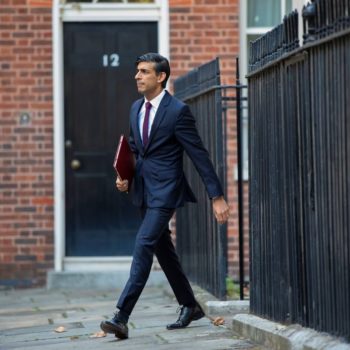The EU’s new Industrial Strategy sets a challenging goal: for European industries to be world leaders in innovation, digitalisation and decarbonisation.
This is a real opportunity for Europe: clean economy sectors are growing rapidly worldwide, and the race for comparative advantage remains wide open. The EU budget can help these goals be met, but needs to be reformed and refocused to succeed. This briefing sets out the 10 steps needed for the EU budget to support world-leading European industrial innovation, digitalisation and decarbonisation.
Investing in innovation
Global markets in advanced technologies are becoming more competitive. Europe’s leadership on research and innovation is increasingly challenged. Despite increasing expenditure on R&D within the EU, in 2014 China overtook the EU in gross research and development expenditure and has also overtaken the EU in clean energy investment (on a per capita basis as well as in absolute terms).
R&D spending in the EU and China

1. Double clean innovation spending
Pressure on the next EU budget will be high, and this will require refocusing spending on areas of the highest added value. The ‘High Level Group on maximising impact of EU Research and Innovation Programmes’, chaired by Pascal Lamy, has recommended that EU budget spending on research and innovation should double over the next MFF period. 35% of current Horizon 2020 spending is reserved for climate-related purposes. For the next budget period, a doubling of clean innovation spending, in line with the proposed expansion in research and innovation investment, is a minimum benchmark on what would be required.
2. Partner with the private sector
Public investment in research and innovation will only ever represent a small proportion of total investment in this area – so it is important to connect public and private spending to maximise investment in decarbonisation. The Breakthrough Energy Coalition, for example, is a group of private investors dedicated to broad investment in new energy technologies. Public and private investment will be able to cover different segments of the innovation chain, but need open and sustained cooperation to succeed.
A ‘mission-oriented’ budget
Successful innovation requires not only sufficient volumes of investment but sufficient direction and focus. Analysis of the public innovation programmes internationally shows that the most impactful are those with a long-term cross-cutting ‘mission-oriented’ perspective that enable them to go beyond sector silos.
3. Structure EU budget spending around industrial challenges
As a result, the EU budget should clearly identify the priority industrial decarbonisation challenges it seeks to address, and link up research, innovation and deployment spending. Examples of ‘mission-oriented’ priorities include:
Low embodied-carbon materials: industrial emissions resulting from the production of basic materials such as steel, cement and chemicals are amongst the biggest challenges for meeting long term climate goals, but industrial innovation in this area is also an opportunity to keep industrial production in Europe.
Clean mobility: major advances in electrification, automation and digitisation have the potential to transform the transport sector. Europe can be at the forefront of this transformation, but it needs to scale up investment in both innovation and in infrastructure deployment.
Smart, flexible energy: As more renewable energy is deployed, the innovation challenge moves from lowering the cost of generation technologies to creating new ways of managing energy systems – including integrating power, heat, transport and digital infrastructures.
Creating market pull
Innovation requires more than a ‘technology push’ from research and development: it also relies on an effective ‘market pull’ to transfer innovative technologies to the broader market.
Technology innovation chains

4. Use the power of procurement to build new markets
The EU budget represents 1% of EU GDP but its impacts are much larger. In some countries, EU budget spending represents 40-80% of public infrastructure investment. By incentivising procurement of low-carbon goods and materials – including those developed as a result of EU innovation spending – EU budget investment can help kick-start new markets in these sectors and create a template for other national administrations to follow.
5. Plug the gap between innovation and deployment
Developers of innovative technology often complain about the ‘valley of death’ between research and development – where support is available – and commercial deployment. EU budget spending can help bridge this gap, by explicitly targeting early stage deployment as part of wider investment programmes. New grid technologies, for example, could be deployed through Connecting Europe Facility investments – but the instrument is not currently designed to support innovation.
Streamlined and consistent spending
Beyond the level and direction of financing, the quality and effectiveness of spending also needs to be improved. The innovation and funding landscape under the MFF is complex and often confusing. More focus is needed on strengthening project pipelines and ensuring consistency of direction.
6. Build the investment pipeline
A key barrier to innovation is the difficulty of ensuring the right projects find the right shape of funding. Researchers, start-ups and innovative businesses cannot be expected to master the complexities of the European financial landscape as part of their business model. Instead, more active support is needed in helping to construct successful project pipelines. This includes expanding the role of the European Investment Advisory Hub and giving it a specific mandate to support projects linked to innovation, digitalisation and decarbonisation.
7. Link national plans to budget spending
Between now and 2020, all EU member states will develop ‘National Energy and Climate Plans’ to set out their energy and climate objectives to 2030 and longer-term 2050 decarbonisation objectives. Ideally these plans should provide a strong investment pipeline and signal for technology innovation. An explicit link should be created between the national plans and EU budget spending. This could incentivise increased ambition from member state, as well as ensuring EU spending matches national priorities.
8. Eliminate fossil fuel subsidies
To be most effective all EU budget spending needs to point in the same direction. Continuing to invest public money in fossil fuels disrupts market opportunities for innovative low carbon industries and increases the cost and complexity of the transition. Along with the rest of the G7, the EU committed in 2016 to phase out fossil fuel subsidies by 2025. Delivering this commitment means eliminating fossil fuel spending within the next budget period.
A transition for cities, regions and communities
Industrial transitions do not happen in the abstract: they take place in specific cities, regions and communities. Some have already been successful in taking advantage of the benefits of clean innovation, through smart specialisation and the agglomeration effect. Others are facing up to challenging industrial transitions and are looking to new industries and technologies to create new sources of prosperity to replace industries in decline.
9. Give cities a direct role in setting budget priorities and allocations
Cities and regions play a special role in the innovation landscape. They integrate multiple systems (energy, mobility, communications) as well as bringing together multiple sources of public and private investment. In many cases, city authorities are more ambitious on innovation, digitalisation and decarbonisation than national governments. In recognition of this role, cities and regions should have a more active role in setting budget priorities and allocations, to enable them to drive clean innovation more directly.
10. Target support to communities at risk from the industrial transition
While innovation, digitalisation and decarbonisation on aggregate is expected to lead to more and better growth and jobs, it poses major challenges to communities highly dependent on older industries that are exposed to the effects of automation, digitalisation and climate policy. These communities need targeted support – in skills and training and in regional development – to support them to take advantage of the economic opportunities offered by industrial innovation and to ensure a socially just transition. Mechanisms for identifying communities at risk and supporting this transition should be built into a reformed cohesion policy in the next EU budget.



